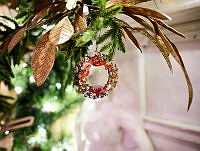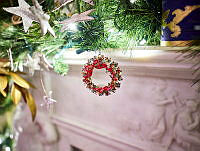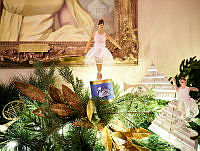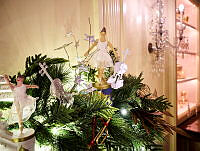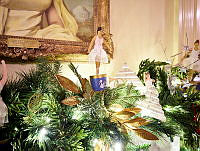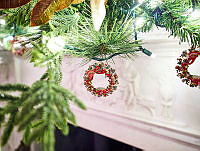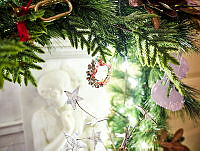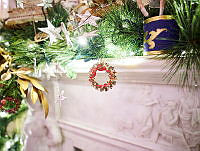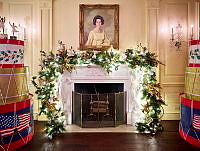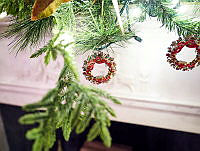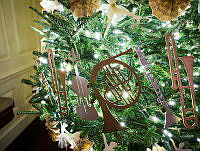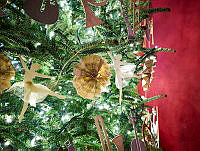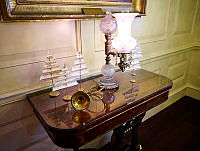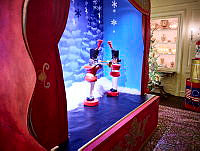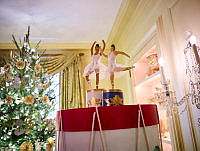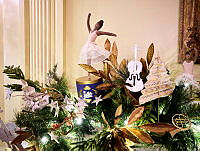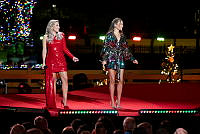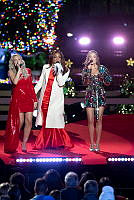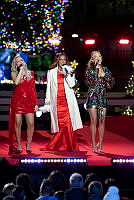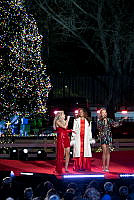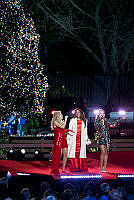Rubenstein Center Scholarship
The President of the United States Meets the King of Rock ’n' Roll
Elvis Presley's Visit to Richard Nixon's Oval Office
Today, one of the most requested photographs from the National Archives and Records Administration (NARA) shows President Richard Nixon shaking hands with Elvis Presley in the Oval Office. Although the photograph is iconic, the story behind this impromptu historic meeting is even more remarkable.

In this photograph, taken on December 21, 1970, President Richard M. Nixon and Elvis Presley greet one another in the Oval Office. Out of concern for the country Presley wrote Nixon a letter suggesting he be appointed a Federal Agent at Large. Nixon agreed and granted Presley a federal narcotics badge during this visit. Presley gifted the president a pistol and some family photos for hosting the meeting.
Nixon Presidential Materials Project, National Archives and Records AdministrationAround 6:30 a.m. on December 21, 1970, after taking a red eye flight from Los Angeles, Elvis Presley appeared at the northwest gate of the White House with a six-page letter, written on American Airlines stationary.1 He handed the letter to a guard and requested a short meeting with the president to deliver a “personal gift.” Presley instructed the White House to contact him at The Washington Hotel, where he was staying under the name Jon Burrows. His letter included several unusual requests. He wanted to be made a “Federal Agent at Large” and to help with curbing American drug abuse and other problems because he had an “in” with various counterculture groups:
“First, I would like to introduce myself. I am Elvis Presley and admire you and have great respect for your office. I talked to Vice President Agnew in Palm Springs three weeks ago and expressed my concern for our country. The drug culture, the hippie elements, the SDS, Black Panthers, etc., do not consider me as their enemy or as they call it the establishment. I call it America and I love it. Sir, I can and will be of any service that I can to help The Country out. I have no concern or Motives other than helping the country out. So I wish not to be given a title or an appointed position. I can and will do more good if I were made a Federal Agent at Large and I will help out by doing it my way through my communications with people of all ages. First and foremost, I am an entertainer, but all I need is the Federal credentials.”2

The singer collected various law enforcement badges and ultimately sought a badge from the Bureau of Narcotics and Dangerous Drugs (BNDD), today known as the Drug Enforcement Agency (DEA). His previous requests for a badge had been denied, but he hoped President Nixon could help him obtain one. According to his friend Jerry Schilling’s memoir, Me and a Guy Named Elvis, Presley had a deep respect for law enforcement because they often helped protect him during concerts and other events. He began collecting honorary badges from the various police departments that protected him. However, following a significant security threat in Las Vegas, Presley sought credentials that would allow him more protection. In particular, he sought a badge that would allow him to travel with the guns he felt were required for his personal safety. His wife Priscilla Presley also shed some light on this in her memoir, Elvis and Me: “The narc badge represented some kind of ultimate power to him. With the federal narcotics badge, he [believed he] could legally enter any country both wearing guns and carrying any drugs he wished.”3
The strange letter soon made its way through the West Wing while Elvis returned to his room at The Washington Hotel.4 Deputy Assistant to the President Dwight L. Chapin wrote a memo to White House Chief of Staff H.R. Haldeman detailing the request, along with Presley’s letter to the president. He encouraged Haldeman to persuade Nixon to take the meeting instead of pushing it off to his Vice President Spiro Agnew, noting that the two had already met in Palm Springs and that it “can be extremely beneficial for the President to build some rapport with Presley.” In the memo he also alerted Haldeman that Deputy Assistant to the President for Domestic Affairs Egil “Bud” Krogh, Jr., would meet with Presley to discuss a meeting with the president. Haldeman approved the meeting for the end of the president’s open hour that afternoon, although he wrote in the margin of the memo, “You must be kidding.”5

Later that morning Krogh invited Presley to his office on the second floor of the Old Executive Office Building. Elvis arrived at 10:10 a.m. along with his friend Jerry Schilling and bodyguard Sonny West. According to Krogh’s recollections, the pair primarily discussed ways Presley could assist the country’s youth through his music to tackle the nation’s drug problem. Krogh was particularly interested in this, writing, “We could sure use your help with the President’s drug program. It’s very hard for us to reach young people around the country.” Once Krogh received word from Chapin that Haldeman confirmed a meeting with the president, he informed Presley of the 12:30 p.m. meeting time.6
Following his meeting with Krogh, Elvis met with BNDD staff and requested a badge from BNDD Deputy Director John Finlator, who ultimately denied the request. When Elvis arrived back at the White House with West and Schilling around 11:45 a.m., an issue arose with Secret Service. According to Krogh, he received a call from Secret Service agent Bill Duncan who informed him that Presley had arrived with a Colt .45 pistol in a display case with silver bullets to give to President Nixon as a gift. Although Secret Service did not allow Presley to take the gun into the Oval Office citing security concerns, they accepted the gift on behalf of the president.7

At 12:45 p.m., Krogh ushered Elvis Presley into the Oval Office. President Nixon greeted the singer formally, preferring to address him as Mr. Presley rather than Elvis. White House Photographer Oliver F. Atkins snapped the famous photograph of the pair shaking hands. After initial greetings, The King of Rock 'n’ Roll began showing Nixon his collection of law enforcement badges as well as signed photographs of his wife Priscilla and daughter Lisa Marie. Nixon steered the conversation to ways that Presley could help reach the nation’s youth and the singer responded that he could best reach people through his music and “just singing.”8
From there the meeting took an unexpected turn when Presley remarked that The Beatles promoted anti-American themes. Although Nixon was surprised by this commentary, he attempted to maneuver the conversation back to ways Presley could help the administration. Then, Presley emphatically indicated to the president that he was “on [his] side” and that he had received a lot of support from America over the years and wanted to repay it. He noted that he had been personally studying drug culture and was accepted by many Americans, including “the hippies.” He also asked Nixon for a badge from the BNDD, and the president agreed, although declining to appoint him as an honorary agent. At the conclusion of the meeting, Presley continued to express his support for the president and with his left arm drew Nixon in for an unexpected hug. Presley also asked if Nixon would greet West and Schilling, and the president obliged. Nixon gifted each of the men a pair of cuff links. Then Elvis remarked, “You know sir, these men have wives,” prompting the president to secure gold pins with the Presidential Seal for each of their spouses.9
Following the meeting, Krogh accompanied the trio out of the Oval Office and took them through the Roosevelt Room where they briefly looked at a portrait of President Theodore Roosevelt. Presley, West, and Schilling joined Krogh for lunch at the West Wing’s Navy Mess. Elvis dressed in a purple suit, was met with shocked stares from other staff members already eating. According to Krogh, “Even though White House staff members were accustomed to seeing heads of state, athletic champions, and movie stars, Elvis was still the King to many of them and in a class of royalty by himself. They all gaped.”10
Following lunch, at 2:00 p.m. the group headed back to Krogh’s office in the Old Executive Office Building and BNDD Deputy Director John Finlator arrived with a badge in hand. Finlator presented Presley with the badge, acknowledging that his original decision had been changed by the president. With that Elvis, West, and Schilling departed, concluding their impromptu White House visit.11 Although efforts were made to conceal the meeting at Presley’s request, word eventually got out. On January 27, 1972, Washington Post reporter Jack Anderson detailed the visit in an article titled “Presley Gets Narcotics Bureau Badge.”12

Although this meeting between Presley and Nixon was certainly unusual, the visit and its purpose is particularly interesting when considered in context with Presley’s desire to obtain the BNDD badge and his own personal drug use. Priscilla Presley’s assertion that he wanted the badge to legally enter other countries with drugs along with guns for protection, suggests a different motivation for Presley’s White House visit. In addition, Presley displayed erratic behaviors and had many health problems during the later years of his career, possibly fueled by prescription drug use.13 Elvis Presley died seven years after this meeting on August 16, 1977, at the age of forty-two. Although the coroner determined the cause of death to be coronary arrhythmia, the toxicology report revealed a dangerous mix of opiates and quaaludes in his system at the time of death. Ultimately, it seems that Presley had an opioid addiction fueled by pills prescribed by his longtime doctor, George Nichopoulos.14
Despite these complications, both Elvis Presley and Richard Nixon remembered the meeting positively. On December 31, 1970, President Nixon sent a letter thanking Presley for the commemorative World War II Colt .45 pistol: “You were particularly kind to remember me with this impressive gift, as well as your family photographs, and I am delighted to have them for my collection of special mementos.” Today, the pistol remains within the holdings of the Richard Nixon Presidential Library and Museum, while Presley’s Memphis estate, Graceland, houses his BNDD badge.15













